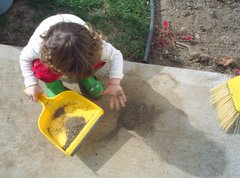 When saying the rosary of Our Lady, it is best to meditate on each of the mysteries-- mostly incidents in the life of Jesus. This evening I thought about the fourth sorrowful mystery, "Jesus carries His cross up Calvary." During this painful and difficult journey, Jesus would likely have gotten splinters in his hands from the roughly hewn wood. A good meditation is to compare Jesus' splinters with the splinters we get in our own lives. The lesson is to bear small wounds willingly and silently.
When saying the rosary of Our Lady, it is best to meditate on each of the mysteries-- mostly incidents in the life of Jesus. This evening I thought about the fourth sorrowful mystery, "Jesus carries His cross up Calvary." During this painful and difficult journey, Jesus would likely have gotten splinters in his hands from the roughly hewn wood. A good meditation is to compare Jesus' splinters with the splinters we get in our own lives. The lesson is to bear small wounds willingly and silently.I searched for the type of wood of the cross and found lots of guesses, including olive wood, cedar of Lebanon, cypress, planetree, and dogwood. Yet no ancient resource exists that tells us which kind of wood was used to construct the cross of Jesus Christ.
The old Catholic Encyclopedia identifies the wood as pine, which would have many splinters.
A microscopic examination of the fragments of the Cross scattered through the world in the form of relics reveals the fact that it was made from a pine-tree (Rohault de Fleury, "Mémoire sur les instruments de la Passion", Paris, 1870, 63).Everything has some very interesting comments about the Aleppo Pine that grows in dry climates in the Mediterranean region.
The Aleppo pine, also known as Jerusalem pine, and its close relative, the Brutian pine, are a fixture in the Mediterranean....The Aleppo pine is a tree used in the service of false gods that may have been used to crucify the real God-man, Jesus Christ. Don't forget that "groves" is used 24 times in the Old Testament to describe the the outdoor places located in or near trees where pagan altars and images were displayed and worshipped. The wooden cross of Jesus is a great sign of contradiction, even more so when we consider the history of the Aleppo pine and Jesus' sacrificial death on the cross.
This pine grows rather quickly, reaching a respectable height within five years and eventually growing to a height of about 20m (60'), especially if spaced in parks or reforestation projects. It will live to be about 150 years old. In the wild it's often shorter and stunted specimens can be seen living a precarious existence on steep, rocky inclines. Its timber has been used in construction and shipbuilding since ancient times.
There is one theory that says that the Aleppo pine is the original Christmas tree. That actually makes sense. Although we associate the Christmas tree with the spruce or larch of northern climates and surround it with very un-Mediterranean quantities of snow, the pine was the sacred tree of Attis. Now Attis was a thoroughly solar god, and this widespread evergreen figures prominently in his myth and rites, one of which is the winter solstice feast which Christians adopted early on in their history and long before Christianity spread to northern Europe. In the spring equinox rite a pine was cut down and on it was placed an effigy of the god that was then taken to his mother Cybele. Attis would rise on the third day.
So there you have it. Next time you see a Christmas tree, think of easter bunnies. The pine, either Aleppo or Brutian since the ancients didn't really make the distinction between different conifers, is generally thought to be the "fir" of the Hebrew scriptures and, according to one myth, it was blessed by the infant Jesus when it hid the Holy Family during their flight from Herod. The tree also figured in the rites of Bacchus....







